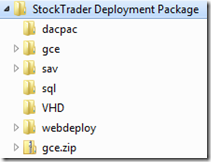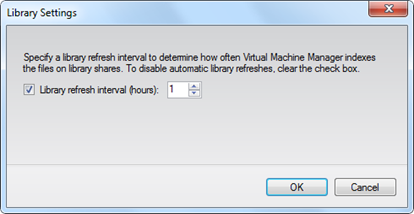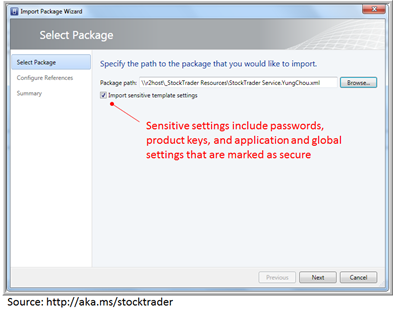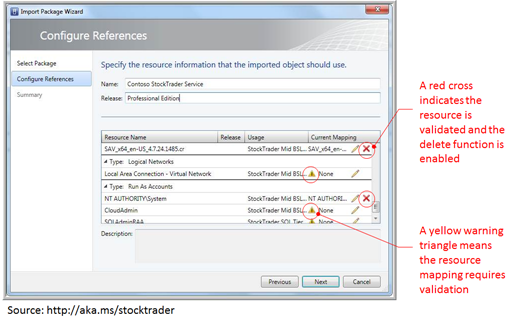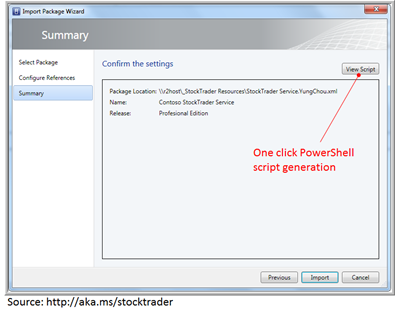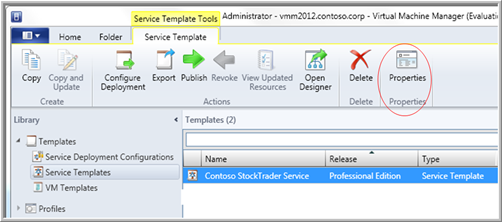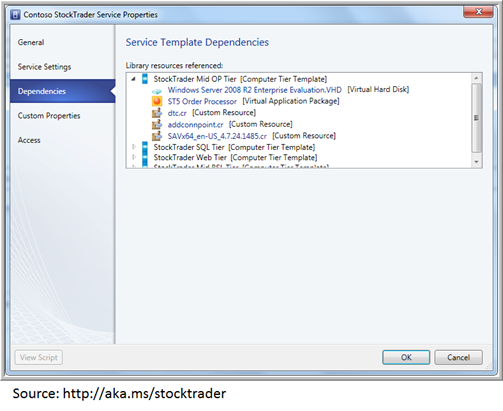Deploying StockTrader Application as Service to Private Cloud with System Center Virtual Machine (VMM) 2012 (2/5): Importing Service Template into Library Share
To deploy an application as a service to a private cloud in VMM 2012, a service template is the key. In this second article of the 5-part blog post series as shown below, let’s walk through the process to make a service template ready for use.
- Part 1: Scenario and Lab Environment

- Part 2: Importing Service Template into Library Share (This article)
- Part 3: Changing Service Template
- Part 4: Deploying Service Template to Target Private Cloud
- Part 5: Managing Service Instance
For those who would like to build a test lab, download Windows Server 2008 R2 SP1 and System Center products including VMM 2012. There are also free eBooks and posters illustrated many important concept of virtualization.
 This is a main delivery of VMM 2012. And a noticeable differentiator from VM 2008 R2 is VMM 2012 is designed with the service concept and a private cloud in mind. A service in VMM 2012 is a set of VMs collectively delivering a business function, and they are configured, deployed, operated, and managed as a whole. And a service template is a vehicle to realize the service concept.
This is a main delivery of VMM 2012. And a noticeable differentiator from VM 2008 R2 is VMM 2012 is designed with the service concept and a private cloud in mind. A service in VMM 2012 is a set of VMs collectively delivering a business function, and they are configured, deployed, operated, and managed as a whole. And a service template is a vehicle to realize the service concept.
Physically an XML file, a service template encapsulates “everything” needed to do a push-button deployment of an application architecture with a running instance of an target application. Just imagine all the knowledge and tasks other than hardware allocations involved in an application deployment from application architecture to configurations, operations, and procedures are all orchestrated and encapsulated in this XML file. Here the hardware allocation is managed by VMM 2012 with the private cloud fabric and transparent to an application. And specifically “everything” of an application deployment I mean:
|
Importing into Private Cloud Fabric
To deploy an application as a service into target private cloud, first make all resources relevant to the deployment visible in private cloud fabric. And this can be easily done by simply first xcopy the StockTrader package, as shown on the right, into a library share of a VMM 2012 already configured as part of the private cloud fabric. (The information to download StockTrader is detailed at the end of Part 1.) Then in the admin console of VMM 2012, import the service template as shown above.
By default VMM 2012 refreshes a library share in 60 minutes as shown below. Depending on how often changes are introduced as well as the network topology and bandwidth, this refresh interval should be set.
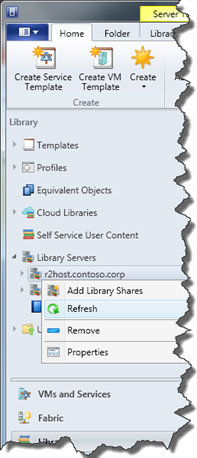 As needed, an administrator can simply right-click and manually refresh a library share in VMM 2012 admin console, as shown on the left here, to index and make a newly added resource available upon refresh. Once the application package appears in the library share, we can now import the StockTrader service template. As VMM 2012 reads in the content of a service template for the first time, all resources referenced by the service template are validated against the private cloud fabric settings. For instance, when developing/testing application in a development environment, the employed credentials and network naming are often different from those in production. Individual settings must be validated against the corresponding ones in a target environment. Once validated, the application and associated resources become ready for employment in the private cloud fabric.
As needed, an administrator can simply right-click and manually refresh a library share in VMM 2012 admin console, as shown on the left here, to index and make a newly added resource available upon refresh. Once the application package appears in the library share, we can now import the StockTrader service template. As VMM 2012 reads in the content of a service template for the first time, all resources referenced by the service template are validated against the private cloud fabric settings. For instance, when developing/testing application in a development environment, the employed credentials and network naming are often different from those in production. Individual settings must be validated against the corresponding ones in a target environment. Once validated, the application and associated resources become ready for employment in the private cloud fabric.
Recall that fabric is an important abstraction in cloud computing and signifies the ability to discover, identify, and manage computing resources. The presumption is that if a resource is added into one of the three resource pools in private cloud fabric, it can be discovered, identified, and managed by VMM 2012. And the importing process is in essence to examine a service template and flag settings for corrective actions, as applicable, such that all resources referenced by the service template are validated via an associated library servers where the resources reside.
The following illustrates the process of importing the StockTrader service template. If you want to import sensitive settings such as passwords, product keys, and application and global settings that are marked as secure, select the Import sensitive template settings check box. If you do not want to import sensitive data, you can update the references later the import process.
When VMM 2012 examines a service template, those references not properly resolved are list with yellow waning triangles. In such case, edit and validate an entry by clicking the pencil icon. Each entry with a red cross is actually an indicator that the referenced resource is validated, as shown below.
Like many Microsoft products, behind the scene, it is implemented with PowerShell. And a set of scripts associated to a series of operations with specified settings can be easily generated for later batch processing and automation. The following shows the View Scripts button available for generating PowerShell script during a service template import process.
Upon a successfully import, the service template is now listed as a resource available for deployment. Check the properties, as shown below, to reveal important information including service settings and dependencies defined in the service template.
StockTrader is a 4-tier application and in the service template properties, as illustrated below. The VHD, server app-v package, customization scripts, etc. to be installed are all listed under an associated VM template. When instantiating a VM instance, these dependencies become in effect and ensure all requirements are orchestrated and met along a deployment process.
At this time, the StockTrader service template is successfully imported and ready for use. Next is to examine the application architecture defined and configured in the service template. Life is good so far.
